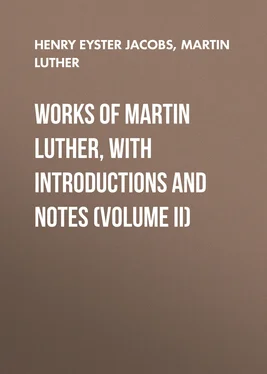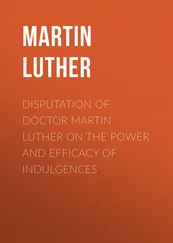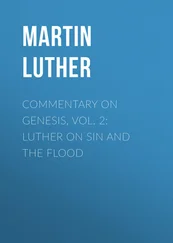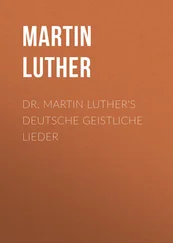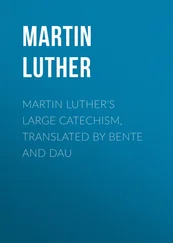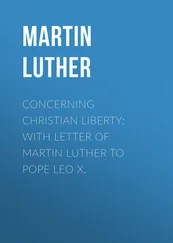Henry Eyster Jacobs - Works of Martin Luther, with Introductions and Notes (Volume II)
Здесь есть возможность читать онлайн «Henry Eyster Jacobs - Works of Martin Luther, with Introductions and Notes (Volume II)» — ознакомительный отрывок электронной книги совершенно бесплатно, а после прочтения отрывка купить полную версию. В некоторых случаях можно слушать аудио, скачать через торрент в формате fb2 и присутствует краткое содержание. Жанр: foreign_prose, foreign_religion, Философия, foreign_psychology, foreign_antique, на немецком языке. Описание произведения, (предисловие) а так же отзывы посетителей доступны на портале библиотеки ЛибКат.
- Название:Works of Martin Luther, with Introductions and Notes (Volume II)
- Автор:
- Жанр:
- Год:неизвестен
- ISBN:нет данных
- Рейтинг книги:3 / 5. Голосов: 1
-
Избранное:Добавить в избранное
- Отзывы:
-
Ваша оценка:
- 60
- 1
- 2
- 3
- 4
- 5
Works of Martin Luther, with Introductions and Notes (Volume II): краткое содержание, описание и аннотация
Предлагаем к чтению аннотацию, описание, краткое содержание или предисловие (зависит от того, что написал сам автор книги «Works of Martin Luther, with Introductions and Notes (Volume II)»). Если вы не нашли необходимую информацию о книге — напишите в комментариях, мы постараемся отыскать её.
Works of Martin Luther, with Introductions and Notes (Volume II) — читать онлайн ознакомительный отрывок
Ниже представлен текст книги, разбитый по страницам. Система сохранения места последней прочитанной страницы, позволяет с удобством читать онлайн бесплатно книгу «Works of Martin Luther, with Introductions and Notes (Volume II)», без необходимости каждый раз заново искать на чём Вы остановились. Поставьте закладку, и сможете в любой момент перейти на страницу, на которой закончили чтение.
Интервал:
Закладка:
148
On the annates, see Vol. I, p. 383, note 1. Early in their history, which dates from the beginning of the XIV. Century, the annates ( fructus medii temporis ) had become a fixed tax on all Church offices which fell vacant, and the complaint of extortion in their appraisement and collection was frequently raised. The Council of Constance restricted the obligation to bishoprics and abbacies, and such other benefices as had a yearly income of more than 24 gulden. The Council of Basel (1430) resolved to abolish them entirely, but the resolution of the Council was inoperative, and in the Concordat of Vienna (1448) the German nation agreed to abide by the decision of Constance. On the use of the term "annates" to include other payments to the curia, especially the servitia , see Catholic Encyclopedia, I, pp. 537 f.
Luther here alleges that the annates are not applied to their ostensible purpose, viz., the Crusade. This charge is repeated in the Gravamina of the German Nation presented to the Diet of Worms (1521), with the additional allegation that the amount demanded in the way of annates has materially increased (A. Wrede, Deutsche Reichstagsakten unter Kaiser Karl V. , II, pp. 675 f.). Similar complaints had been made at the Diet of Augsburg (1518), and were repeated at the Diet of Nürnberg (Wrede, op. cit. , III, 660). Hutten calls the annates "a good at robbery" ( Ed. Böcking, IV, 207). In England the annates were abolished by Act of Parliament (April 10, 1532)
149
On the crusading-indulgences, see Vol. I, p. 18.
150
i. e., As was done by the Council of Basel. See above, p. 84, note i.
151
The canons are the clergy attached to a cathedral church who constituted the "chapter" of that cathedral, and to whom the right to elect the bishop normally belonged.
152
This whole section deals with the abuse of the "right of reservation," i. e., the alleged right of the pope to appoint directly to vacant church positions. According to papal theory the right of appointment belonged absolutely to the pope, who graciously yielded the right to others under certain circumstances, reserving it to himself in other cases. The practice of reserving the appointments seems to date from the XII Century, and was originally an arbitrary exercise of papal authority. The rules which came to govern the reservation of appointments were regarded as limitations upon the authority of the pope, The rule of the "papal months," as it obtained in Germany in Luther's time, is found in the Concordat of Vienna of 1448 (Mirbt, Quellen , 2d ed., No. 261, pp. 167 f.). It provides that livings, with the exception of the higher dignities in the cathedrals and the chief posts in the monasteries, which all vacant in the months of February, April, June, August, October and December, shall be filled by the ordinary method—election, presentation, appointment by the bishop, etc.—but that vacancies occurring in the other months shall be filled by appointment of the pope.
153
i. e., Church offices which carried with them certain rights of jurisdiction and gave their possessors a certain honorary precedence over other officials of the Church. See Meyer in Realencyk. , IV, 658.
154
Charles V, though elected emperor, was not crowned until October 22d.
155
i. e., A living which has not hitherto been filled by papal appointment.
156
This rule, like that of the "papal months," is found in the Concordat of Vienna. Luther's complaint is reiterated in the Gravamina of 1521. (Wrede, Deutsche Reichstagsakten , etc., II, 673.)
157
Des Papstes und der Cardinale Gesinde , i. e., all those who were counted members of the "family" or "household" (called Dienstverwandte in the Gravamina of 1521) of the pope or of any of the cardinals. The term included those who were in immediate attendance upon the pope or the cardinals, and all those to whom, by virtue of any special connection with the curia, the name "papal servant" could be made to apply. These are the "courtesans" to whom Luther afterwards refers.
158
In 1513 Albrecht of Brandenburg was made Archbishop of Magdeburg and later in the same year Administrator of Halberstadt; in 1514 he became Archbishop of Mainz as well. In 1518 he was made cardinal.
159
This rule, like the others mentioned above, is contained in the Concordat of Vienna.
160
Cf. The Gravamina of 1521, No. 20, Von anfechtung der cordissanen (see above, p. 88, note 3), where the name cordissei is applied to the practice of attacking titles to benefices. (Wrede, op. cit. , II, pp. 677 f.)
161
The pallium is a woolen shoulder-cape which is the emblem of the archbishop's office, and which must be secured from Rome. The bestowal of the pallium by the pope is a very ancient custom. Gregory I (590-604) mentions it as prisca consuetudo ( Dist. , C.c. 3). The canon law prescribes ( Dist. C. c. I ) that the archbishop-elect must secure the pallium from Rome within three months of his election; otherwise he is forbidden to discharge any of the duties of his office. It is regarded as the necessary complement of his election and consecration, conferring the "plenitude of the pontifical office," and the name of archbishop. Luther's charge that it had to be purchased "with a great sum of money" is substantiated by similar complaints from the XII Century on, though the language of the canon law makes it evident that Luther's other contention is also correct, viz., that the pallium was originally bestowed gratis. The sum required from the different archbishops varied with the wealth of their sees, and was a fixed sum in each case. The Gravamina of 1521 complain that the price has been raised: "Although according to ancient ordinance the bishoprics of Mainz, Cologne, Salzburg, etc., were bound to pay or the pallium about 10,000 gulden and no more, they can now scarcely get a pallium from Rome for 20 or 24 thousand gulden." (Wrede, op. cit. , II, 675.)
162
The oath of allegiance to the pope was required before the pallium could be bestowed ( Dist. C, c. I). The canon law describes this oath as one "of allegiance, obedience and unity" (X, I, 6, c. 4).
163
See above, p. 86, note 2.
164
cf. Luther to Spalatin, June 25, 1520 (Enders, II, 424; Smith, No. 271).
165
i. e., The benefices are treated as though they were vacant.
166
In the case of certain endowed benefices the right to nominate the incumbent was vested in individuals, usually of the nobility, and was hereditary in their family, This is the so-called jus patronum , or "right of patronage." The complaint that this right is disregarded is frequent in the Gravamina of 1521.
167
Commendation was one of the practices by which the pope evaded the provision of the canon law which prescribed that the same man should not hold two livings with the cure of souls. The man who received an office in commendam was not required to fulfil the duties attached to the position and when a living or an abbacy was granted in this way during the incumbency of another, the recipient received its entire income during a subsequent vacancy. The practice was most common in the case of abbacies. At the Diet of Worms (1521), Duke George of Saxony, an outspoken opponent of Luther, was as emphatic in his protest against this practice as Luther himself (Wrede, op. cit. , II, 665); his protest was incorporated in the Gravamina ( ibid. , 672), and reappears in the Appendix ( ibid. , 708).
Читать дальшеИнтервал:
Закладка:
Похожие книги на «Works of Martin Luther, with Introductions and Notes (Volume II)»
Представляем Вашему вниманию похожие книги на «Works of Martin Luther, with Introductions and Notes (Volume II)» списком для выбора. Мы отобрали схожую по названию и смыслу литературу в надежде предоставить читателям больше вариантов отыскать новые, интересные, ещё непрочитанные произведения.
Обсуждение, отзывы о книге «Works of Martin Luther, with Introductions and Notes (Volume II)» и просто собственные мнения читателей. Оставьте ваши комментарии, напишите, что Вы думаете о произведении, его смысле или главных героях. Укажите что конкретно понравилось, а что нет, и почему Вы так считаете.
